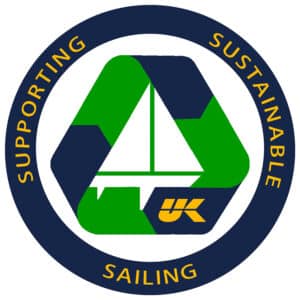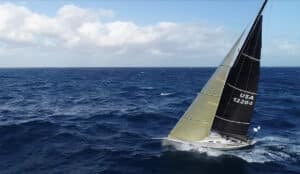A SwedeStar 37 showing her X-Drive Carbon sails with double-sided black taffeta. Even though the jib has a luff tape that goes into the headstay foil, this jib can be slab reefed just as easily as those with hanks. Click on photos to enlarge.
Many sailors are aware how quickly and efficiently reefing your mainsail will help you get your boat back under control when the wind picks up. Tucking a reef and shaking it quickly can be easy once your boat is set up properly and you have practiced. If taking a reef doesn’t depower you quite enough, and you don’t have a roller reefing genoa, you’ll need to change to a smaller headsail, which can be a lengthy and cumbersome task – especially for doublehanded and singlehanded sailors. To help shorthanded sailors reduce headsail area quickly, UK Sailmakers offers jibs and genoas that can be slab reefed as a way to quickly to get the boat back under control.
Above: The reefed part of the sail is shown tied up. Below: The reefed part is rolled and then zipped away with an integral zipper system.
Just like slab reefing a main, when reefing the headsail, you lower the halyard, attach the reef tack, re-tighten the halyard, and then trim the sheet. To simplify your life as the wind pipes-up, we design these headsails’ reef clew height so that the sails will trim to the same track position as when un-reefed. Finally, either tie or zip up the unused lower part of the sail and continue to sail.
Roller reefing is a compromise that reduces sail area at the expense of sail shape. The distorted sail shapes created by roller furling are notoriously ugly – there are wrinkles, the draft moves aft and the leech hooks. The luff curve and most of the broad-seamed shape is in the front of the sail, which is removed during roller reefing. On the other hand, with slab reefing you don’t lose the sail’s designed shape. During slab reefing, whole sail is lowered a few feet and if the sail has horizontal leech flattening battens, they are not affected by the reefing process. Shown here is the Express 37 LORA ANN with a slab reef in her 140% genoa. This boat mostly races doublehanded and benefits from the reef while sailing upwind once the wind goes over 12 knots.
The catamaran sequence shows a reef being put jib on 24-foot Streaker cat PARADACTYL. The sail is dropped, the sheets are moved from the clew to the reef clew and then the foot is folded up and the reefed part of the sail is rolled and then zipped away. UK Sailmakers can build in a zipper system for sails that will stay reefed for long periods of time. Finally, the sail is raised and the zipped-up section can be seen at the bottom of the sail. To shake the reef, lower the sail, unzip the rolled-up section, re-attach the jib’s tack, move the jib sheets and then re-set the sail.
Hanks are not a requirement for reefable jibs. The last sequence shows a sail with luff tape being reefed on a SwedeStar 37. The sail has a tack take-down line that goes from the reef tack, through the tack shackle and then back to a winch in the cockpit. As the halyard is eased, tack line pulls the reef tack to the tack fitting. Once the reef tack is set, the halyard is re-tensioned. Then the sail is sheeted in. Notice how the sail keeps a perfectly smooth, flat airfoil shape.
Keep in mind that being reefable is a compromised that trades ease of reducing sail area for optimal performance. For the sail to be strong enough for use reefed in heavy air, the sail will be constructed too heavy for lighter winds when you can handle a full-sized sail.
To learn more about reefable jibs and genoas, contact UK Sailmakers today.



